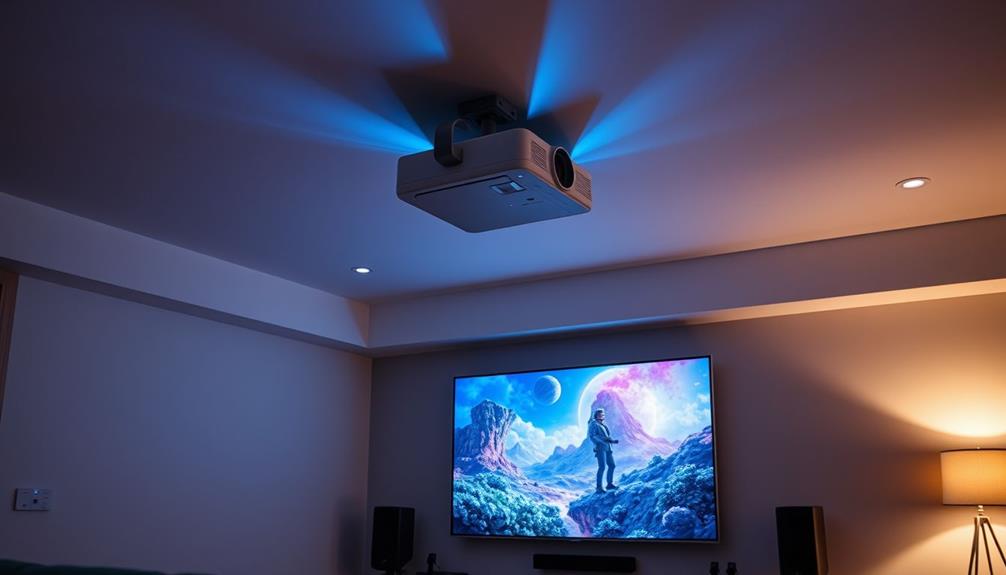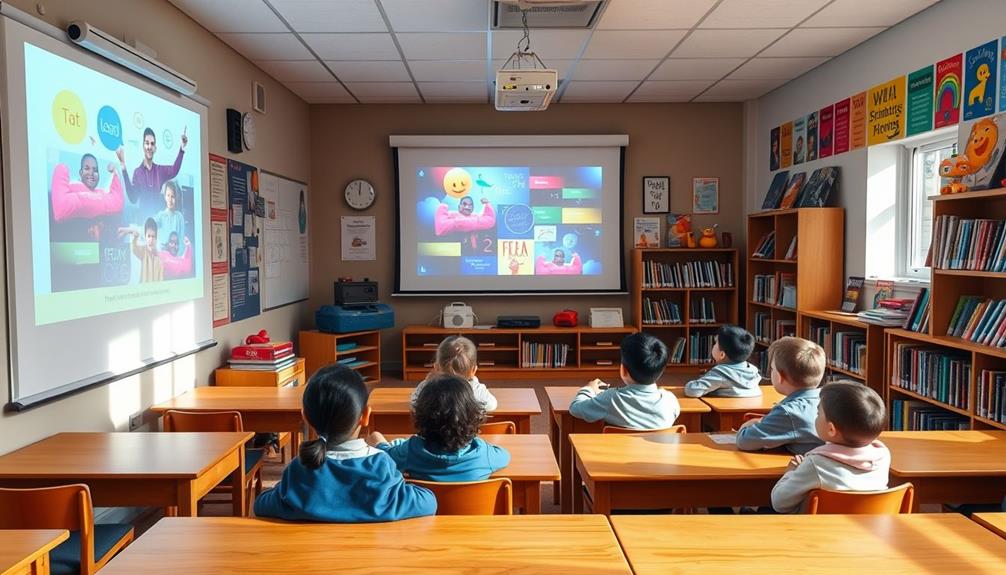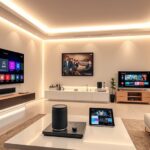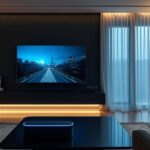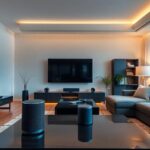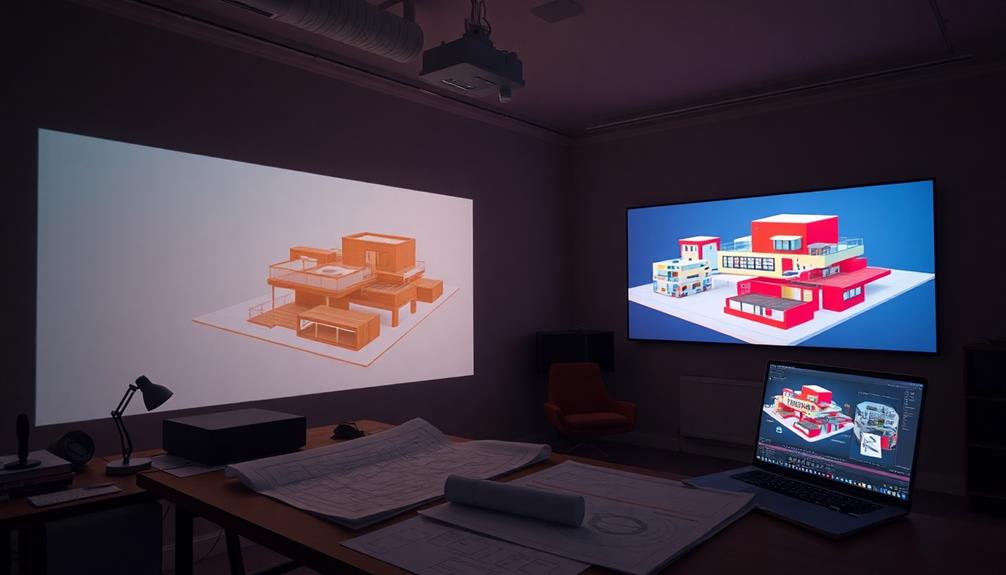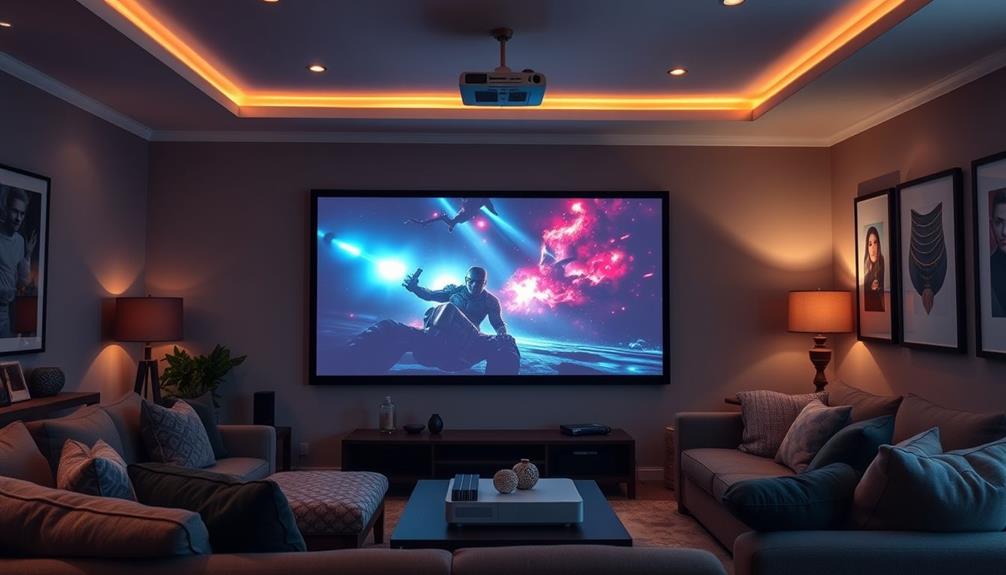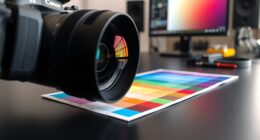To integrate your projector with smart home systems, start by ensuring it supports Wi-Fi and HDMI-CEC. Connect it to your home Wi-Fi for seamless communication with other smart devices. Use smart control apps to manage your devices from one interface. Set up voice control through assistants like Alexa or Google Assistant for easy access. Create automated scenes for specific activities, like a movie night, adjusting lighting and sound with a single command. Ideal projectors will have built-in smart features for a streamlined setup. Explore the possibilities further to enhance your home entertainment experience.
Key Takeaways
- Ensure your projector supports HDMI-CEC and connects to Wi-Fi for seamless communication with smart home devices.
- Verify compatibility with popular smart home platforms like SmartThings and Alexa for easy integration.
- Utilize voice control features by confirming compatibility with assistants like Amazon Alexa or Google Assistant.
- Set up automation scenes to synchronize your projector with lighting and climate controls for an enhanced viewing experience.
- Regularly update your projector's software to maintain compatibility with new streaming services and smart home features.
Benefits of Smart Home Integration
When you integrate your projector with a smart home system, you access a world of convenience and enhanced entertainment. This setup revolutionizes your streaming experience by allowing you to control all your smart devices with just one command.
Imagine effortlessly dimming the lights, adjusting the temperature, and setting up your projector for movie night without lifting a finger. Additionally, using high-quality headphone extension cables can further enhance your audio experience, ensuring that sound quality remains pristine even in a smart environment.
With voice control, you can easily switch between content sources or adjust settings using your smart assistant, eliminating the need for multiple remotes. This not only simplifies your viewing routine but also makes it fun and interactive.
Creating unique automation scenes for different activities, like gaming or watching sports, transforms your home theater into a more immersive environment. No more fiddling with manual adjustments; everything responds to your voice or predetermined settings.
Moreover, integrating your projector with smart home systems can actually increase your property's value, appealing to both tech-savvy buyers and casual viewers who crave advanced entertainment solutions.
Essential Components for Integration
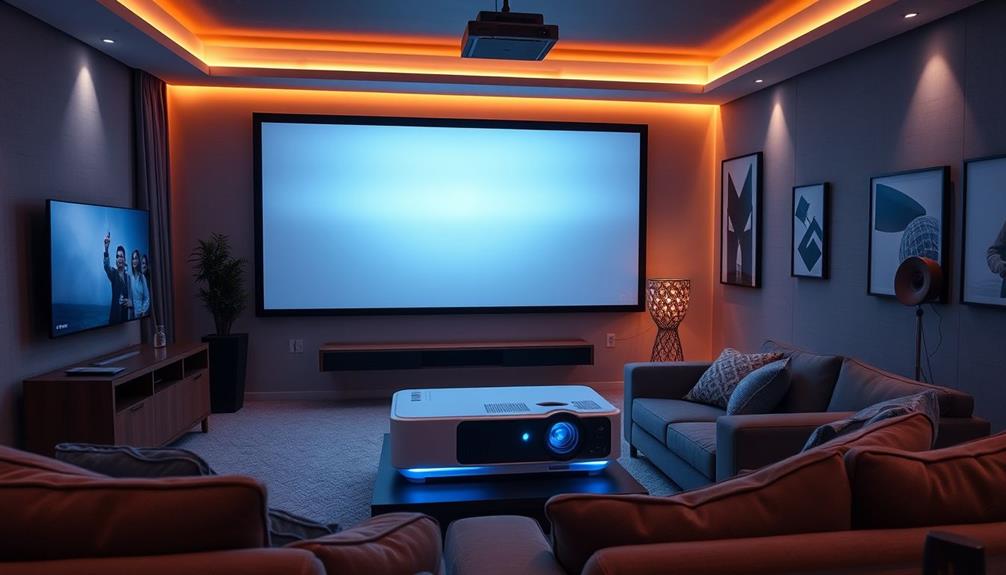
To successfully integrate your projector with smart home systems, you'll need to focus on smart control applications and device compatibility.
Consider exploring various island getaways for inspiration on how to create an immersive viewing environment.
Make sure your projector can communicate with your existing smart home hub and other devices for smooth operation.
This compatibility will enhance your viewing experience and streamline your setup process.
Smart Control Applications
Smart control applications play an essential role in integrating projectors with smart home systems, making your viewing experience more dynamic and user-friendly. Apps like the BenQ Smart Control enhance projector functionality by giving you access to popular streaming services and offering an intuitive user interface for easy navigation.
Additionally, as AI applications in various industries continue to evolve, they increasingly support seamless integration with smart home devices, providing users with enhanced automation options.
When you integrate your projector with platforms like SmartThings or HomeKit, you achieve seamless integration, allowing for automation that connects your projector with other smart devices in your home. You can set up automation scenes that trigger multiple actions, such as lowering the projector screen and adjusting lighting, all with a single command.
This greatly boosts your convenience and enhances your home entertainment experience.
Moreover, the ability to connect your projector with mobile devices through screen mirroring or casting makes sharing content and presentations effortless.
Regular software updates for smart control applications guarantee that your projector stays compatible with new streaming services and devices, optimizing its performance over time.
Device Compatibility Considerations
Many projectors on the market today come with essential features that confirm seamless integration with smart home systems. When considering device compatibility, focus on key elements that enhance your experience.
First, verify your projector supports HDMI and USB connections, as these are standard for connecting streaming devices like sticks and gaming consoles. Additionally, using a projector in conjunction with an air purifier's effectiveness can improve the overall viewing experience by maintaining clean air in the room.
Next, check for compatibility with popular smart home automation platforms such as SmartThings or HomeKit. This can notably simplify control over your projector and other devices.
Wireless connectivity options, like Wi-Fi and Bluetooth, are also vital, allowing you to stream content effortlessly from smartphones and tablets.
Additionally, verify that your projector supports voice control through assistants like Amazon Alexa or Google Assistant. This feature not only enhances user convenience but also makes it easier to manage your projector alongside other smart devices.
Lastly, consider projectors with built-in smart features, such as Android TV integration. This can streamline your access to streaming services, reducing the need for external devices and making it easier to enjoy content on your projector screen.
Keep these device compatibility considerations in mind for a smooth integration process.
Setup and Compatibility Considerations
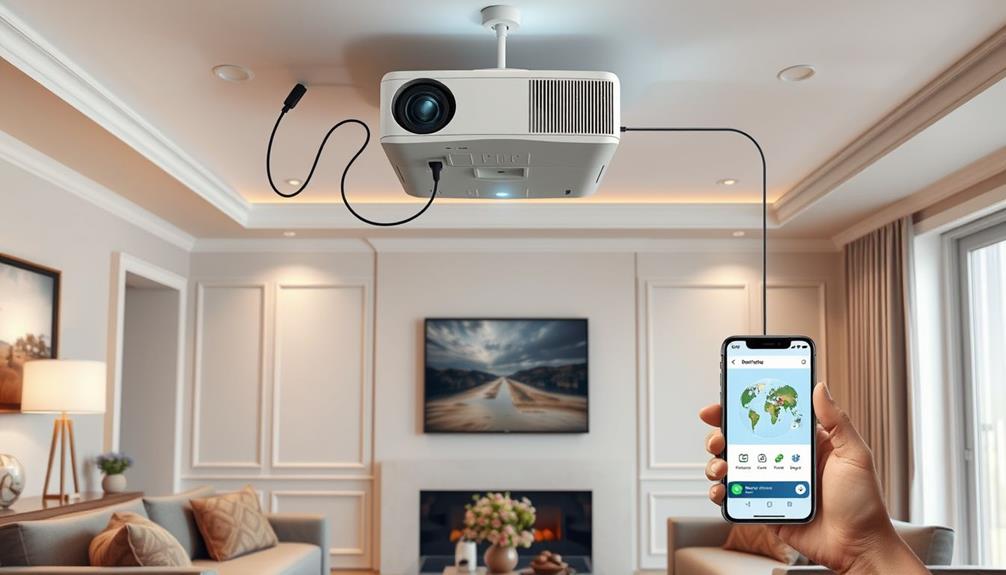
Guaranteeing seamless integration of your projector within a smart home setup requires careful attention to compatibility and setup processes. First, check if your projector supports smart home integration with popular platforms like SmartThings, HomeKit, or Alexa. This compatibility enhances your control and automation options.
Additionally, creating a serene and cozy workspace, such as a Cottagecore Home Office, can further improve your viewing experience. During the initial setup, connect your projector to your home Wi-Fi network. This step enables streaming and allows your smart home devices to communicate effectively, facilitating voice control and automation scenes.
Utilize an HDMI cable to connect your projector, and verify it has HDMI-CEC (Consumer Electronics Control) capabilities. This feature allows you to control multiple devices through a single remote, simplifying your user experience.
Don't forget to integrate smart lighting and climate control systems with your projector. This integration creates a customized viewing environment, adjusting lighting and temperature based on your preferences.
Automation and Control Options
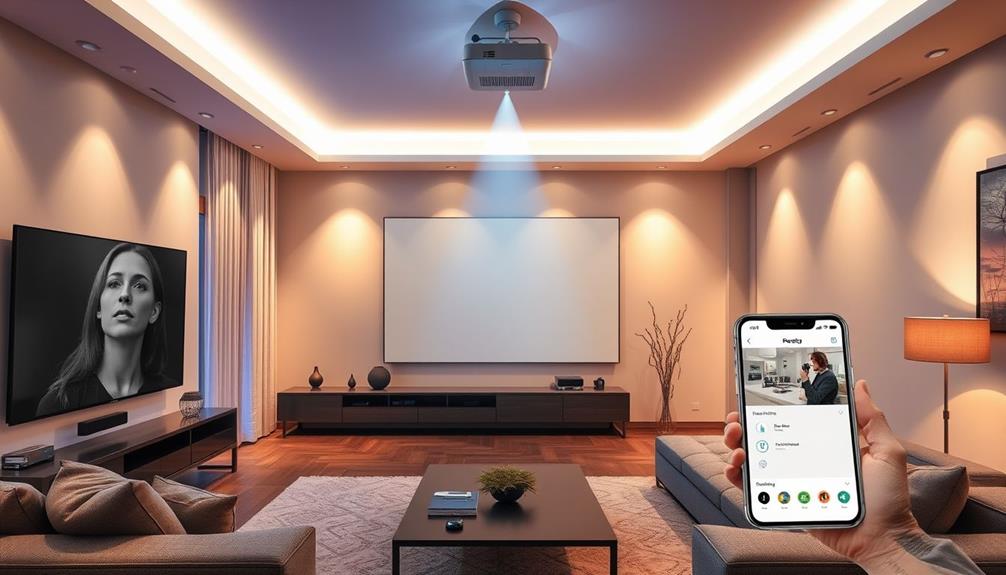
When it comes to automating your projector within a smart home setup, you can streamline your viewing experience with just a few commands. By integrating your projector with smart home systems, you can create automation scenes that control multiple devices simultaneously.
For instance, you can dim the lights and adjust the projector settings with a single command, setting the perfect ambiance for movie night. Utilizing effective offers can greatly boost customer interest, making your viewing environment even more enjoyable as you tailor it to your preferences email marketing essential for small business growth and outreach.
Utilizing voice assistants like Amazon Alexa or Google Assistant makes it even easier. You can activate your projector and adjust settings using simple voice commands, eliminating the need for multiple remotes.
Plus, smartphone apps offer remote control options, enabling you to tweak brightness, volume, and source selection from anywhere in your home.
Additionally, you can synchronize your projector with smart lighting systems, allowing the room's ambiance to automatically adjust based on the selected movie or activity. Incorporating smart home hubs like SmartThings enhances this automation experience by facilitating seamless communication between your projector and other smart devices.
With these control options at your fingertips, you'll enjoy a more convenient and immersive viewing experience.
Enhancing User Experience
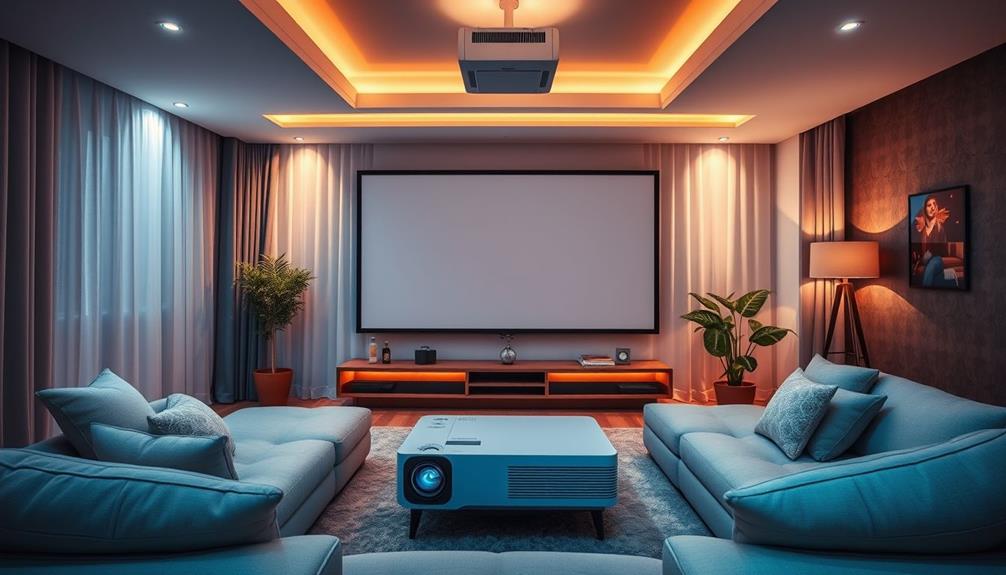
When you integrate your projector with smart home systems, seamless connectivity makes your viewing experience effortless.
This innovative approach allows you to control various aspects of your environment, such as lighting and sound, to create the perfect atmosphere for movie nights. You can personalize settings to match your mood or activity, ensuring that every movie night feels just right.
For instance, consider how stylish wall clocks can enhance your space while helping you keep track of time during your entertainment sessions.
This level of customization not only enhances convenience but also transforms how you enjoy entertainment at home.
Seamless Device Connectivity
Integrating your projector with smart home systems not only simplifies device management but also elevates your viewing experience. With Smart Home Technology, you can achieve seamless control over multiple devices using a single interface, eliminating the clutter of multiple remotes. This keyword clustering strategy enhances user experience by guaranteeing that all your devices can work together harmoniously.
Platforms like SmartThings or HomeKit allow you to create automated scenes that adjust your projector's settings alongside lighting and audio, perfect for movie nights or gaming sessions.
Wireless connectivity options, such as AirPlay for iOS devices or screen mirroring for Android, enable you to effortlessly cast content to your projector without the hassle of physical cables. This means you can quickly share videos or presentations without any interruptions.
Incorporating voice assistants like Amazon Alexa or Google Assistant adds another layer of convenience. You can easily turn on your projector, adjust settings, or switch inputs using just your voice.
Regularly updating your projector's firmware and connecting it with smart home hubs guarantees compatibility with new devices and features, maintaining a streamlined and efficient smart home ecosystem. Embracing these technologies enhances your overall experience, making entertainment more accessible and enjoyable.
Personalized Viewing Settings
With personalized viewing settings, you can transform your home entertainment experience into something truly special. By leveraging smart home systems, you can create automation scenes that adjust lighting, audio, and projector settings with just one command.
Imagine saying "Movie time!" to your voice assistant and instantly having the lights dim, shades lower, and sound system optimize for that cinematic experience. Utilizing essential tools for creating enchanting music tracks can enhance your audio experience even further, ensuring your soundscapes are as immersive as your visuals.
You can also customize audio settings through integration with surround sound systems, ensuring the perfect audio quality whether you're watching films, listening to music, or diving into gaming sessions. This adaptability not only enhances your enjoyment but also simplifies your routine.
To keep your settings aligned with your preferences, regularly assess your needs. As technology evolves, so can your personalized viewing settings, allowing you to enjoy an ever-improving experience.
Whether it's a cozy movie night or an intense gaming marathon, the right automation scenes and voice assistant integration can elevate your enjoyment to new heights. Embrace the convenience and sophistication of personalized viewing settings, and make every movie night or gaming session truly unforgettable.
Security and Safety Measures
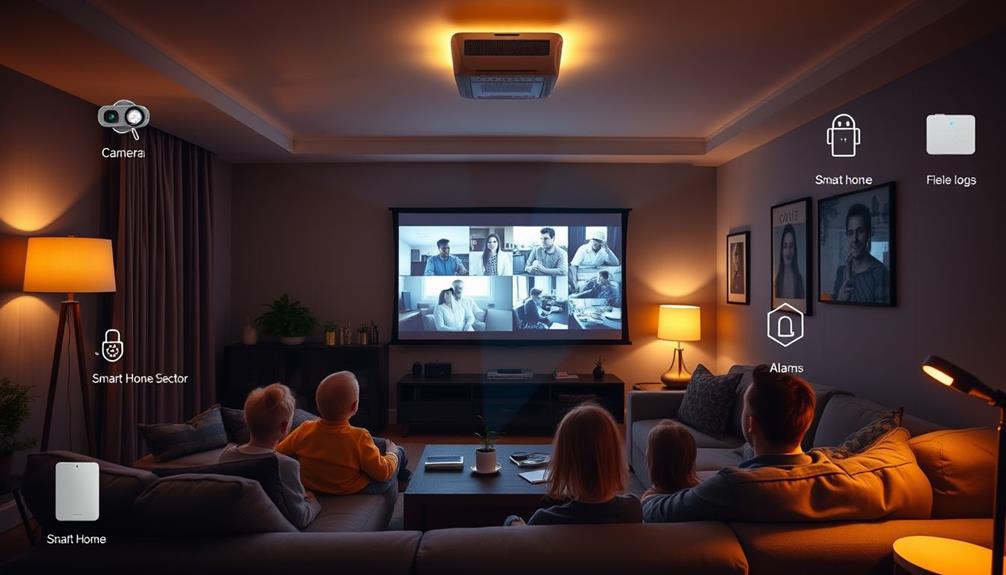
Security and safety measures are vital for protecting your projector and enhancing your overall home entertainment experience. By integrating your projector with smart home security systems, you can guarantee a secure environment for both your equipment and guests.
For instance, installing surveillance cameras allows you to remotely monitor the projector area, giving you peace of mind during your movie nights. To further enhance your understanding of security trends, you might explore recent posts that cover various security topics.
Consider using smart locks to restrict access to your home theater. This protects your valuable projector from unauthorized use or theft, making it an excellent safety measure.
Additionally, implementing integrated smoke and carbon monoxide detectors within your smart home ecosystem can alert you to emergencies, further enhancing safety during events.
A reliable Wi-Fi connection is essential for the functionality of your smart devices. Make sure your network security is robust to prevent unauthorized access to your home automation systems.
Finally, don't forget about regular updates for all connected devices. This careful planning maintains both security and performance, reducing vulnerabilities that could compromise your safety measures.
Cost and Budgeting Strategies

When planning your smart home projector setup, budgeting wisely is key to ensuring you get the best value for your investment. Establish a budget that typically ranges from $500 to $2,000, factoring in both the projector's cost and any additional smart devices for seamless integration.
Here's a quick breakdown to help you organize your expenses:
| Expense Type | Estimated Cost |
|---|---|
| Projector & Devices | $500 – $2,000 |
| Installation (DIY) | $150 |
| Installation (Professional) | $1,000+ |
Don't forget to account for ongoing costs, like subscription fees for streaming services, averaging $10 to $30 monthly. Furthermore, set aside 10-15% of your total budget for unexpected expenses or future upgrades, as technology evolves rapidly.
Future Integration Possibilities
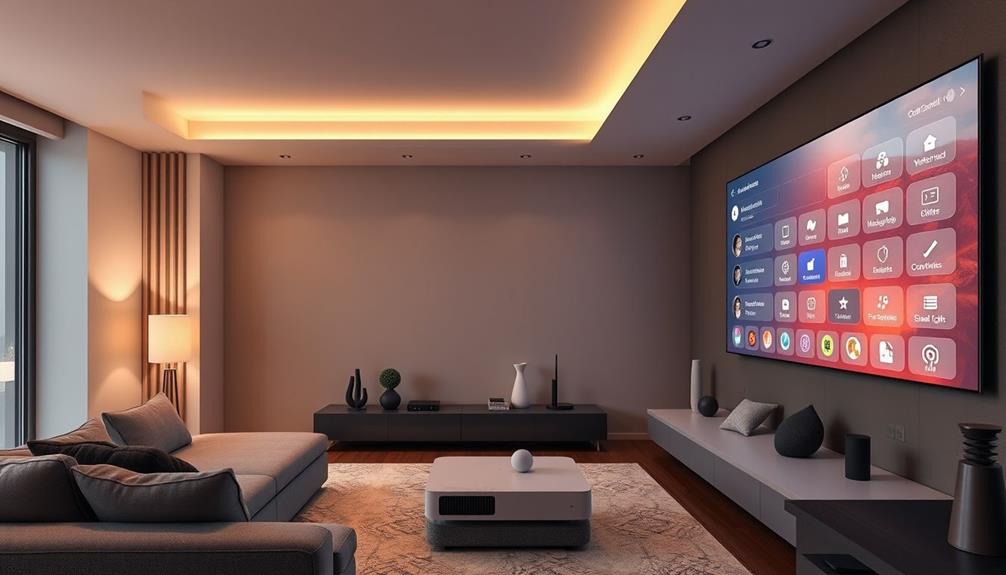
Imagine a future where your projector seamlessly integrates with every aspect of your smart home. With emerging platforms like Matter, you'll enjoy enhanced compatibility across brands, making it easier to connect your projector with various devices.
Future integration possibilities include automation features that sync your projector with home lighting and climate control, creating the perfect ambiance for your movie nights. Picture the lights dimming and the climate adjusting as your favorite film begins, all without lifting a finger.
Moreover, integrating voice assistants like Amazon Alexa or Google Assistant will revolutionize how you control your projector. You'll simply say, "Start the movie," and watch as everything works together effortlessly.
As technology advances, smart projectors may even offer AI-driven content recommendations based on your viewing habits, streamlining your selection process and tailoring experiences to your preferences. Imagine a system that knows exactly what you want to watch next!
Additionally, future advancements in wireless technology promise to enhance connectivity, allowing for improved casting from mobile devices and integration with multi-room audio systems. This cohesive entertainment experience will make your smart home feel even smarter.
Conclusion
By integrating your projector with smart home systems, you access a domain of convenience and enhanced entertainment. You'll not only enjoy seamless control but also elevate your viewing experience to that of a modern-day cinema. As technology continues to evolve, envisioning future possibilities, like voice-activated projections, becomes less fanciful and more attainable. Embrace this evolution, and you'll find that your home can transform into a sophisticated haven of relaxation and enjoyment.
